The index to the Comics and Music roundtable is here.
______________________
In 1958, an estranged Hungarian Jew and Holocaust survivor named Flóra “Florence” Klein brought her eight-year-old son, Chaim Witz, to New York City from Israel to seek out a new and better life. Chaim Witz’s name was soon Americanized to Gene Klein, and would eventually become the infinitely more famous double-alter ego Gene Simmons.
But let’s not get ahead of ourselves.
After a year in an Orthodox Jewish school, the young Klein made his transition to America complete by entering the New York City public school system. Unable to speak or write English at first, Klein quickly turned to the new and fascinating world of American popular culture to learn his adopted language. While other kids were outside playing baseball or kick-the-can, Klein immersed himself in almost all of the mass entertainment arts: movies, television, science fiction, cartoons, pulps, and especially comic books. Reflecting later about those early years, he said once he saw Superman and Batman, “he was hooked.”
Then, in 1964, at the age of 14, he saw The Beatles on The Ed Sullivan Show, and a new world opened up for him: pop music. As he said decades later in his book Kiss and Make-Up, “My first thoughts about pop music were born that night, and they were simple thoughts: If I go and start a band, maybe the girls will scream for me.”
Klein’s first band was Lynx, announced incorrectly as The Missing Links – the name which ended up sticking – and it consisted of Klein, Danny Haber and Seth Dogramajian. Like Klein, both band-mates were obsessed with comic books. Klein elaborated about their four-color passion: “Seth and I used to publish amateur fanzines about comic books and science fiction. We would write articles, review movies, and talk about characters from television shows. His fanzine was called Exile; mine was called Cosmos. But after the Beatles, it became clear to us that, as much as we loved science fiction, it wasn’t going to get us where we wanted to go with the girls.”
But even as Klein began actively forging ahead on his nascent music career, his entrance into the world of science fiction, comic book, and film fandom exploded.
To say that Klein was an active fan of the popular arts would be a gross understatement. He not only read and collected comic books, monster magazines, film magazines, pulps and related science fiction and fantasy books; he also published his own fanzines and contributed material to scores – perhaps even hundreds – of other fan publications.
From 1965 to 1970 – through the remainder of high school and beyond – Klein’s fanzine-related output was prodigious. Here’s just a partial list of fanzines with which he had involvement: Adventure, Arioch, Asmodeus, Asterisk, Beabohema, Bombshell, Chamber of Horrors, Cooper’s Hero Hobby, Cosign, Cosmos, Cosmostiletto, Crabapple Gazette, Critique, Double: Bill, Dynatron, Ecco, Exile, Famous Fiends of Filmdom, Fantasy Crossroads, Fantasy Film Journal, Fantasy News, Faun, Giallar, Gore Creatures, Harpies, Id, Iscariot, Mantis, Martian Journal (MJ), Men of Mystery, Monstrosities, One Step Beyond, Orpheus, OSFan, Osfic, Proper Boskonian, Pulp Era, Quark, Ragnarok, Ray Gun, Sanctum, Satyr, Sci-Fi Showcase, Screen Monsters, Sirruish, Solarite, Space and Time, Spectre, Splash Page, Starling, Super Spy, Terror, Tinderbox, Trumpet, Web Spinner, Weirdom, and Wonderment.
Klein’s contributions were as varied as his popular culture interests. He drew artwork; wrote opinion columns; reviewed films, TV shows, comic books, pulps, books, fanzines and newspaper comic strips; and wrote countless letters of comment.
His signature writing style could be summed up in one word: blunt. Klein rarely pulled his punches. If he thought a fan publication had bad art or a poorly written article, he would not hesitate to say so. Despite this, many editors apparently didn’t mind the abuse, because his letters kept on getting published. So did his sometimes acerbic articles.
For example, in the fanzine Web Spinner #2, published in August 1965, Klein summarily raked Marvel editor Stan “The Man” Lee over the coals in an essay titled “The M.M.M.S.? You Can Keep It!” Klein felt that the $1 membership fee Lee was charging for the new club was exorbitant for what members received in return: a record, a certificate, some Thing stickers, and a coming events news sheet. Klein then went on to discuss some of Marvel’s other merchandising products being concurrently advertised, such as $1 Marvel stationery pads and $1.50 t-shirts. And while he admitted they were nice to look at, he complained, “who has so many dollars to contribute to Lee’s ever-growing pockets?”
However, just about 10 years later, there would be some industrial-strength irony in those words when Klein, as Gene Simmons, would help mastermind a long-running and innovative KISS merchandising machine that would eventually generate hundreds of millions of dollars in revenue – a marketing juggernaut that made Lee’s modest mid-1960s operation look positively quaint by comparison.
Klein’s soon-to-be-considerable entrepreneurial skills started in those halcyon fan days when he started buying and selling comics to finance his hobbies and fledgling music career. He utilized the same mimeograph he used to publish his fanzines to print up flyers and other ads offering to buy old comics for a dollar a pound. He’d then sift through the stacks of purchased comics, re-selling the most collectible ones to other fans at a tremendous mark-up.
As the 1960s came to a close, Klein went off to college and his music career began growing. Something had to give, so Klein’s fan activities began tapering off. But even as late as 1969, Klein and his band-mates were still doing a significant amount of work for fanzines. For example, in the fifth issue of Gordon Linzner’s science fiction fanzine Space and Time, published in the spring of 1969, three of the four contributors providing artwork for the issue were current or former members of a Klein band: Klein, Dogramajian and Steve Coronel.
But, the die was cast, and Klein’s music career soon displaced most of his former fannish activities. In the Dec. 14, 2005 edition of the fanzine Vegas Fandom Weekly, science fiction fan and editor Arnie Katz looked back on Klein’s departure from fandom, circa 1969. “He was originally in horror/SF movie fandom and was only beginning to understand the “faster track” of SF fanzine fandom when his life got very busy,” Katz said. “Bill Kunkel and I (who barely knew each other at the time) both corresponded with Gene and, I think, saw him as a promising young fan. He came along at about the same time, and from the same “other fandom” source, as John D. Berry. John grew into a very fine fan while Gene’s fan career ended due to his musical success.”
Today, several different fandoms claim Klein as one of their own, and they are all technically correct. Klein was, in fan parlance, a “cross-over fan” – i.e., he had a foot in multiple fandoms. But back in those pre-Internet days, unless a fan made his multiple allegiances a point of contention in his letters and essays, few of his peers would have even been aware of them.
There were no overt indications during this period that anything like KISS was in Klein’s future. He and his band-mates rotated in and out of various band iterations as they struggled to find the right mix of musicians and the right sound. However, there is a tantalizing clue in the form of an obscure 1969 fanzine drawing by Klein that could indicate he was dreaming of something bigger four years before KISS was born. The drawing was published on Page 36 of the fanzine Starling #13 as a spot illustration, and it depicts what appears to be a prototype design for the eye makeup Klein (as Simmons) would later wear as his KISS character, The Demon.
In 1970, Klein and band-mate Stanley Eisen formed the band Wicked Lester, which was the precursor to KISS. After two years of struggling unsuccessfully to build the type of band they envisioned, and despite a recording contract with Epic Records, for various reasons the two felt shackled by the arrangement and walked away. This gave them the freedom they needed to start fresh and build a new band from the ground up.
They moved to New York City, found a drummer named Peter Criss (Criscuola), and a lead guitarist named Ace (Paul) Frehley. Around the same time, Gene Klein changed his name to Gene Simmons, Stanley Eisen changed his name to Paul Stanley, and the early versions of their trademark makeup and costumes began to take shape. Stanley coined the name KISS, and although they probably had no inkling of it at the time, the band was ready to make history.
Simmons recalled in KISS and Make-Up how his Demon character persona originally developed. “Later on in our career, when we went to Japan, the reporters there wondered if our makeup was indebted to the Japanese kabuki style. Actually mine was taken from the Bat Wings of Black Bolt, a character in the Marvel comics The Inhumans. The boots were vaguely Japanese, though – taken from Gorgo or Godzilla – and the rest of the getup was borrowed from Batman and Phantom of the Opera, from all the comic books and science fiction and fantasy that I had read and loved since I was a child.”
Simmons also attributed his trademark Demon hand gesture, consisting of the index finger and pinky finger extended, to comic book artist Steve Ditko’s two trademark characters: Spider-Man and Dr. Strange. The former would position his hand that way to shoot webbing from his web-shooter, and the latter would use a similar gesture to conjure up magical spells.
In many ways, Simmons was channeling his inner superhero when he designed his on-stage persona. I don’t think it’s a coincidence that Jack Kirby’s comic book character named the Demon debuted on newsstands just six months before the birth of KISS. As Simmons points out, his own character was an amalgam of many comic book and popular culture influences. Likewise, adopting stage names at the very moment their KISS characters were born was another nod to the superhero’s penchant for having an alter ego. Later, Simmons would even take hiding his alter ego to the next level by covering up the bottom of his face whenever his make-up was off and cameras were around. (KISS bandmate Paul Stanley demonstrates the technique in the picture below.)
The band’s first performance took place at the Popcorn Club, in the New York City borough of Queens, on January 30, 1973. There were three people in the audience, and KISS performed sans make-up. By March, however, the band had started developing its iconic look and four signature characters: The Demon, Starchild, Catman and Spaceman.
According to the 2012 (revised) edition of The Encyclopedia of Heavy Metal, although KISS eventually became one of the most popular bands of the 1970s, they struggled initially to get noticed. KISS released three albums prior to Alive! but the sales were weak. At the same time, their live concert performances were regularly selling out. So the decision was made to release a double album made up entirely of live KISS concert performances. Live albums were still unusual during that era, so it was a bold move – and a highly successful one. Alive! apparently captured the energy and spectacle of KISS’ concerts, making the band members superstars overnight.
KISS had a huge influence on almost every heavy metal band that followed – whether the later bands realized it or not. This “ghost” influence is similar to the influence comic book artist Jack “King” Kirby had on his peers and subsequent generations of comic book artists.
As mentioned earlier, KISS was the first rock band to extensively market and brand itself through merchandising. In the mid-1970s, KISS albums came with an order form insert offering membership into “The KISS Army” for $5, and a host of other KISS merchandise for sale. Suddenly, according to The Encyclopedia of Heavy Metal, KISS products were everywhere. “This may not seem like a big deal today, but at the time it was highly unusual for a band to market itself this aggressively as a commodity.”
To his credit, even as KISS was rocketing to fame, Simmons never forgot his fannish roots, and still kept in touch with some of his long-time fanzine buddies. For example, in 1976, after the KISS World Tour, Simmons wrote a letter of comment that was published in issue #25 of Gore Creatures, a fanzine he had submitted contributions to during the late 1960s while he was still in high school.
The band’s popularity soon opened doors with the very comic book industry Simmons and his early band-mates had adored. “From the beginning I had been heavily indebted to comic books, and in 1978 (sic) we made good on that relationship by getting a comic book of our own,” Simmons said. “First a Marvel artist (sic) named Steve Gerber who was a big fan put us in the last two issues of Howard the Duck. We were demons who possessed Howard. Marvel noticed that those two Howard the Duck issues soared in sales even though we weren’t on the cover. So they approached us about a KISS comic book.”
The very first KISS comic book Marvel published was Marvel Comics Super Special #1, a magazine-sized comic published in September 1977. The rollout of the magazine received national coverage because of a brilliant marketing idea: At Marvel’s printing plant in Buffalo, N.Y., KISS, in full make-up and costume, and in front of the cameras and a notary republic (and Stan Lee, of course), had blood drawn from each band member, after which it was mixed in with the printers ink used for the magazine’s print run. According to Simmons, the issue “became Marvel’s biggest-selling comic book.”
A follow-up magazine-sized comic, Marvel Comics Super Special #5, was published a year later in Dec. 1978. Marvel also published the trade paperback KISS Klassics in 1995, and KISSnation Magazine in 1996.
Since then, KISS has had many other licensed comic books published by a variety of comic book companies. For example, Image published 31 issues of Todd McFarlane’s KISS: Psycho Circus from 1997-2000, followed by four trade paperbacks and five spin-off magazines. Dark Horse was next, publishing a 13-issue series KISS in 2002. Platinum Studios published KISS 4K in 2007, and even Archie Comics got in the act in 2011 when it published, Archie Meets KISS. Most recently, IDW has had a licensing agreement to publish KISS comics, releasing KISS, KISS Greatest Hits, KISS Kompendium, and KISS. And the KISS comic book ties keep on coming…
Like millions of immigrants before him, Simmons came to the United States with nothing but a dream. And whether one likes the music of KISS or not, no one can deny that Simmons took some of his wildest fantasies and turned them into reality – and built a world-wide army of ardent fans in the process.


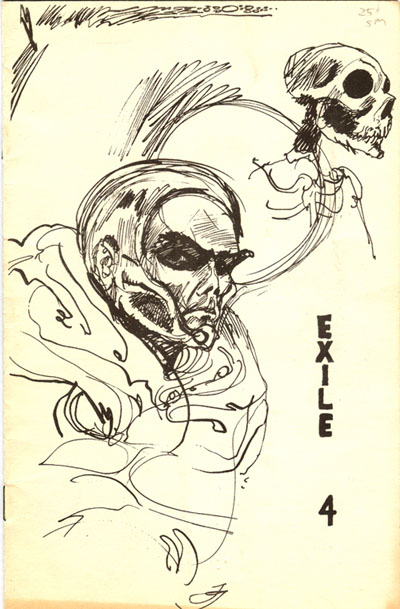
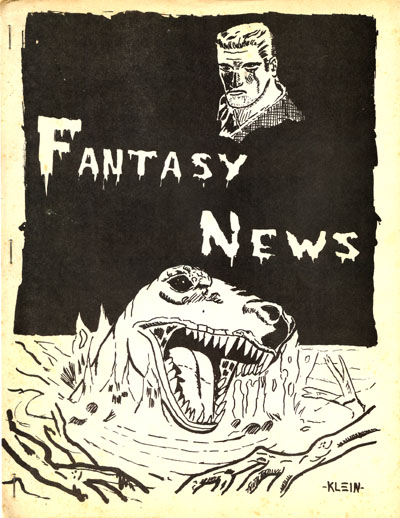
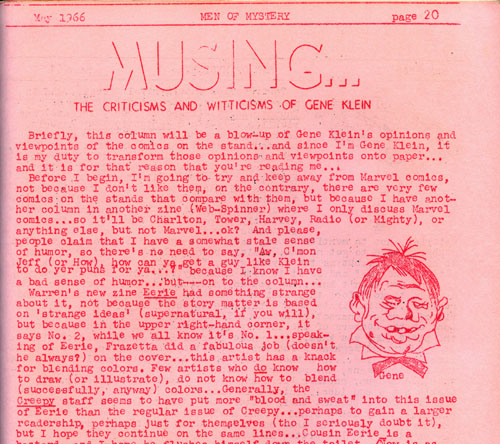
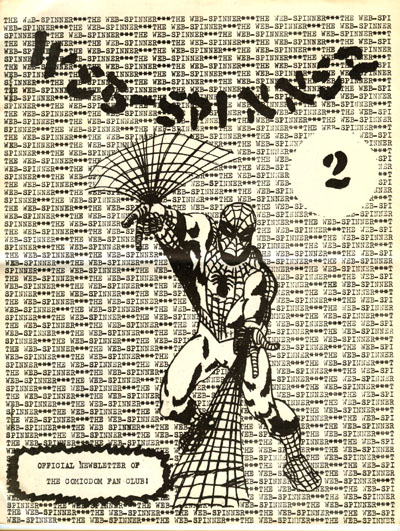
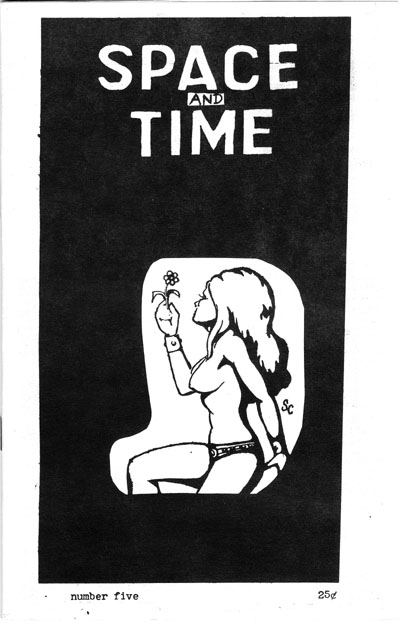
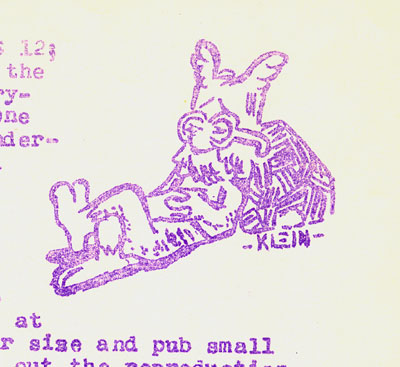


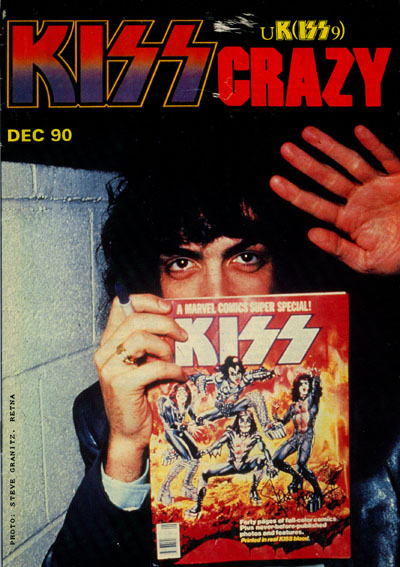



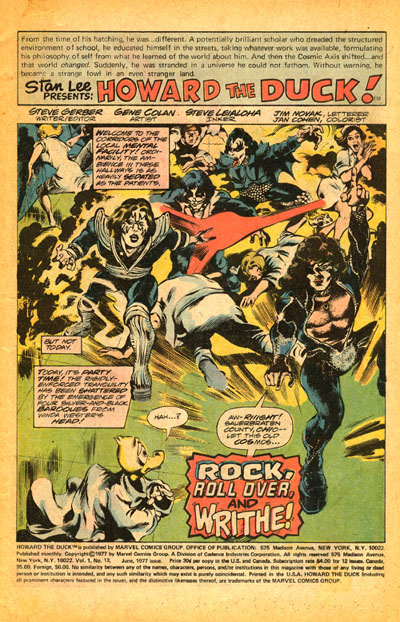
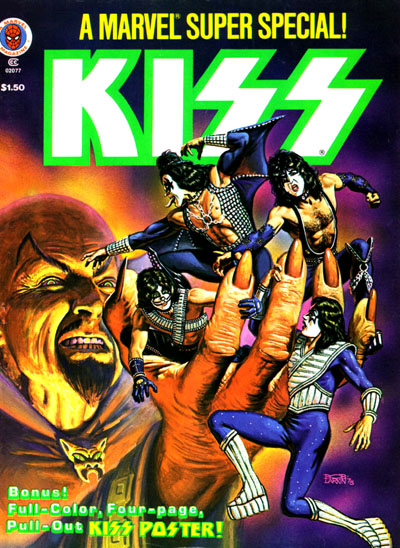
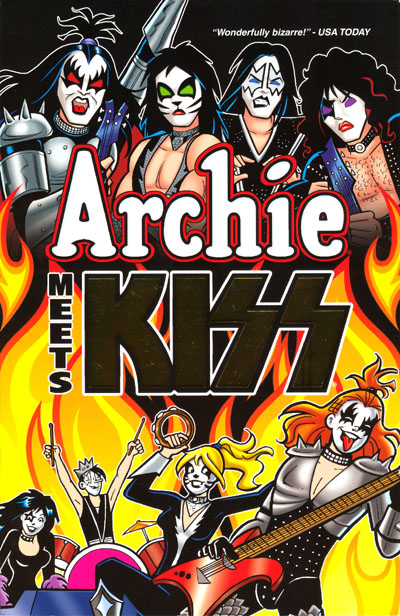
As one of many Gene Klein fanzine collectors, I say nicely done! One comment though, the image of Gene Simmons covering his face with the KISS comic is actually Paul Stanley, if I’m not mistaken. Just fact checkin’ you…
Aaron Caplan
Obviously the effort to disguise his face was successful!
Aaron — You’re right! But I didn’t have an image of Simmons hiding his face — even though he was doing it all the time during that same phase for KISS as well.
By the way, thanks a million for letting me go through all of your ‘zines with Klein contributions. That was a big help!
Pingback: Comics A.M. | Direct market sales up 29% in first quarter | Robot 6 @ Comic Book Resources – Covering Comic Book News and Entertainment
Should be fixed in the piece now…
Thanks Noah!
Getting back to the essay and Simmons’ fanzine contributions, to date, Aaron has compiled a listing of approximately 57 different fanzine titles, and about 138 individual fanzine issues, containing Klein contributions.
But that listing grows every week. Just going through my own vintage ‘zines while doing research for this essay added some new issues to Aaron’s list, and no one knows how many more issues containing material may be out there.
Then there are issues where Klein’s fanzines are advertised or reviewed, or his articles or letters are commented on.
For example, in “Web Spinners” #5, Roy Thomas, who was an assistant at Marvel at the time, writes in to respond to some of Klein’s criticisms of Marvel. So while it may not be a Klein LOC per se, it is definitely something that may be of interest to KISS fans.
Just last night I found a “new” Simmons entry for my checklist: a 1964 horror zine, Giallar #4 (has a Gene Klein LOC in it), probably one of his first published contributions! He would have been 14 or 15 years old. Simmons could not afford to buy fanzines, but knew he’d get a free copy of that zine if he submitted a contribution that was actually printed. It was the accepted practice of the day. Ever the opportunist, Gene contributed an almost inexhaustible stream of letters, art, movie/comic/fanzine reviews, articles, etc, resulting in an immense amount of published work … and a bunch of free fanzines for himself. This was definitely a motivating factor in his publishing of several comic book/sci-fi fanzines including Cosmos, Cosmostilletto, and Faun – he would trade these with other publishers to receive their book, pretty much for the price of postage. I guess $.25 was an enormous sum in the ol’ days. Gene was so prolific that I continue to discover Simmons fan activity and seem to be adding 3 or 4 new entries to my checklist per month. If anyone is interested in a copy of my “Gene Klein Checklist” (it’s in MS Excel) please email me at aaron (AT) fantucchio (DOT) com.
Aaron — You added those two other issues of “Space and Time” I found, right? Let me know if you need the specifics.
I didn’t tell you yet, but he has an edited LOC excerpt in another issue of “Cooper’s Hero Hobby” — I think issue #5 (I’ll check tonight). That’s in addition to his full-blown LOC in “Cooper’s Hero Hobby” #6.
I need an updated version of your list. Mines about a month old.
;)
I added those 2 “Space & Time” zines to the list, but the “Cooper’s Hero Hobby #5” is another new one to me … so the list grows!
Pingback: Gene Simmons and KISS: Channeling One’s Inner Superhero
wow, amazing. Singular self-marketing/fandom crossover juggernaut narrative.
How you like him now, Terri Gross?
So what are you saying, Bert?
Interesting article Russ. I didn’t realize how extensive Gene Simmons’ fannish background really was. Of course the late Roger Ebert got his start writing for ‘zines too.
Daniel — Thanks.
Great minds think alike, because I’ve also been curious about Ebert’s fan activity. Unfortunately, I’ve never run across any of his fan material.
Roger Ebert wrote poetry in Dick Lupoff’s Xero! I’ve seen his poetry in various other sci-fi zines but I can’t recall which ones. Leonard Maltin also got his start writing articles for film fanzines – he was featured in Steve Kelez’s “Amateur Producer’s Magazine.”
Early Ebert:
http://potrzebie.blogspot.com/2011/09/life-itself.html
Great article.
I’ve actually met Gene and my girlfriend has collected a few of his fanzines. Anyway, before the KISS coffee house opening in Myrtle Beach, SC, we found our way to the hotel where Gene was at and met him in this bar/lobby area. I had this “Farewell Tour” banner that I wanted him to sign (which he had never seen one like it before :) ). She had a fanzine or two. He was taken aback by it. He said “I made this when I was 14-15 years old”. Being in our early 20’s he was surprised we even had things like this. I know Gene is a big collector of everything KISS, I even offered my banner to him, but he said no. Anyway that is my fanzine story.
I have a question for the other collectors. I recall some fanzine issue that either Gene drew the picture, or was in the issue. The key component here is that it was a picture of the original X-Men. I think it was the cover, but can’t remember if Gene did the drawing or was just a writing contributor. A scan of that picture would be great. I must have seen it on ebay or something, as another fan I converse with who collects the Gene fanzines doesn’t have or know which one it is.
Pictures of above event:
http://i.imgur.com/RnhRjdx.jpg
http://i.imgur.com/DuUWu1L.jpg
Aaron/Daniel — Thanks for the Ebert glimpses! I exchanged some spirited correspondence with him once in the mid-1970s regarding the Cornel Wilde film “Shark’s Treasure.” I still have the letter somewhere.
Norm — I went through about 50 fanzines with Klein contributions in them but did not see the illustration you’re referring to. I’ll keep my eye out for it though.
Thanks for your ‘zine story. Despite the fact I’ve been a ‘zine publisher and collector since 1974, I didn’t have a clue how extensively involved Simmons, as Klein, was with not just fanzines, but comics.
I didn’t go into it in my essay, but during his 1980s Hollywood phase, Simmons actually played a comic book character for an aborted pilot about Jon Sable.
I think that Sable thing actually aired, with 2 or 3 episodes. Check IMDB?
AB — The Simmons version didn’t, it apparently didn’t turn out so well. Simmons panned his own performance. There’s a page about it in Simmons’ 2003 book “Sex Money KISS”
Here is Gene as Jon Sable:
http://i.imgur.com/ukahIZt.jpg
http://i.imgur.com/xCnpE0h.jpg
Norm – You’re talking about Web Spinner #4! see:
http://www.fantucchio.com/Web-Spinner-04-1966-Feb(997x1295px).jpg
Web Spinner #4 was published in Feb 1966 by Mike Appel, who published quite a few Simmons/Klein columns, letters, etc in this more Marvel-oriented zine, and also in his other horror-zine called “Spectre” (previously known as “Famous Fiends of Filmland”). It had a photo offset cover and ditto (aka “spirit duplicator”) interiors. The cover is actually by a really fantastic fan artist named Steve Kelez, whom I believe sells old-time radio programs on the net these days & maybe does web design. This particular issue is particularly memorable as it features “Merry Marvel’s Mysteriously Marvelous Mystical Marauders” — a 3+ article by Gene Klein on Pages 10-12. Plus it has a Richard Buckler back cover and Buckler interior pin-up). An awesome zine of the 60’s!
Norm – you may have to copy the entire link to see the image of Web Spinner 4’s cover – it doesn’t seem to have picked up the entire chain of letters …
Yes, there was a full-page ditto color illo of the X-Men in “Web-Spinner” #4, but it was drawn by Rich Buckler, not Gene Klein. I read your post on my tiny little iPhone screen and thought initially you were just looking for an X-Men illo DRAWN by Gene.
I actually scanned the Buckler image and will post it here, along with scans of Gene’s 3-page article in the same issue.
Norm – Below are the scans. the formatting may get messed up during the post. If that happens, just copy and paste the entire link. Klein’s article was four pages long, not three.
Buckler X-Men illo:
http://home.comcast.net/~russ.maheras/Web-Spinner-04-1966-Feb-Buckler-pinup-100dpi.jpg
Klein’s four-page article:
http://home.comcast.net/~russ.maheras/Web-Spinner-04-1966-Feb-Klein-Marvel-essay-Page-01-100dpi.jpg
http://home.comcast.net/~russ.maheras/Web-Spinner-04-1966-Feb-Klein-Marvel-essay-Page-02-100dpi.jpg
http://home.comcast.net/~russ.maheras/Web-Spinner-04-1966-Feb-Klein-Marvel-essay-Page-03-100dpi.jpg
http://home.comcast.net/~russ.maheras/Web-Spinner-04-1966-Feb-Klein-Marvel-essay-Page-04-100dpi.jpg
Thanks Aaron and R. Maheras. That isn’t the picture I am recalling in my mind. What I remember I think it was just BEAST. Maybe the circular X in the background. It was black and white (white pages).
Some more stuff: Gene briefly talks about some fanzines in his letters columns (I’m sure there are more): http://www.genesimmons.com/news/082004.html
Here is a little bit more scans of others (if you haven’t seen them) on a KISS board that I was active at:
http://www.mykisslife.net/phpbb/viewtopic.php?t=2411&sid=21564c6d889f33745db65c3e3d1274c8
Norm — If you look at the name on the one extensive fanzine letter to Gene, you’ll see it’s from the same Aaron’s letter, and showed he still remembers quite a bit from his old ‘zine contributing days.
Yeah, when it comes to fanzines, that Caplan guy is everywhere!
;)
Thanks for the other scans!
Oops! What the heck happened? Half my sentence above got chopped off.
I meant to say, that one of the extensive ‘zine letters on the page you linked to was from the same Aaron Caplan who you’ve been trading posts with here.
HA. I hadn’t even noticed. That’s great
That letter to Simmon’s website was the start of my Klein checklist. I was shock that he responded.
I’ve got a response now and then. It’s a great feeling.
Great article. I had heard about some of this stuff just growing up a metal kid and the legend of Gene Simmons being on everything. But I had never seen an of it and never had any idea just how big into that stuff Gene was. Thanks to Russ and all parties involved for posting those scans and links in the comments.
Shannon — Thanks. Simmons’ involvement in various fandoms during the 1960s was huge. And when one looks at the big picture, Simmons isn’t kidding when he says comics and other pop culture mediums had a huge impact on his life.
Russ, a friend wrote a book about Gene, and as much as pop culture, his holocaust survived mother was just as important. It deals with Gene’s childhood as well:
http://www.assoc-amazon.com/e/ir?t=deflepprelare-20&l=as2&o=1&a=1937600580
Fanzines have attracted a lot of interesting folks over the years. Of course Crumb did some ‘zines and in Fanta’s collection of his letters Your Vigor For Life Appalls Me he mentions fandom and his various fannish activities several times.
Certain ‘zine historians seem to really downplay the role of SF/comics ‘zines in favor of music ‘zines, which is odd considering the amount of crossover early on (e.g. Paul Williams and CRAWDADDY, Greg Shaw’s BOMP! etc.)
Daniel — The thing that gets me about fanzines is that most people have no idea how rich and varied the material in fanzines is. Yeah, there are crudzines, but even in the crudzines there are gems — sometimes even mother lodes — of material. If one regularly follows sites like Ken Meyer Jr.’s “Ink Stains,” one can see example after after example of beautiful ‘zines from that era as well
http://comicattack.net/category/inkstains/
I’d love to see some sort of database about vintage ‘zines, because there are probably many hundreds of pro and fan interviews alone that are currently “lost” because no one except a few folks today are even aware they exist.
Every time I sit down with a pile of vintage ‘zines it’s a blast because I never know what forgotten treasure I might find.
Also, ‘zine culture basically had all the features that we now associate with the internet decades earlier: flame wars, trolling (particularly in the APA scene), comparisons one’s opponents to Hitler, etc.
p.s. As you probably know, Dr. Frederic Wertham wrote about fanzines back in 1973!
http://www.amazon.com/The-World-Fanzines-Special-Communication/dp/0809306190
Daniel — Yep! I used that same analogy myself.
Fanzines served the exact same purpose back then as do countless web sites now. The only difference is that communication took a lot longer, so a discussion/argument that took months or even a year or more back then might be over now in days or hours.
I have Wertham’s book, and actually, based on a discussion I just had on Facebook, I was planning on digging it out again to read.
Russ,
Looks like you’re rapidly becoming one of the KISS Army:
http://www.kissonline.com/news/article/id/36576
I am humbled, sir!
BEWARE: If you follow the above link connected to “ShellyHam”‘s, it tries to download a malicious file to your pc! It just drove my Norton AntiVirus crazy.
Sorry about that; I sent it to spam. My apologies.
I watched about an hour of the 1977 KISS concert in Largo and it was pretty impressive — especially for its era. I wasn’t much of a concert-goer back then, so I missed out on seeing KISS live, but a co-worked I talked to a couple of weeks ago told me she saw them perform in 1974 at the Aragon Ballroom in Chicago, and she said the show was “spectacular.” Since she went on to work at several Chicago radio stations after that and went to many, many concerts, I’d say that’s a reliable source.
BTW, even though I’m largely indifferent to the music of KISS, this was a really fun article and thread. More stuff like this please.
I had fun researching the essay, and although it took me awhile to decide exactly how I was going to put it all together, the pieces fell into place once I started writing.
Very fun article.
Norm – Here’s another X-Men cover (probably not the one you’re talking about): Wonderment #1 from 1967. This was a zine published by Mike Raub and Bob Feie (he drew the cover too) and featured a Gene Klein column called “Wonderment. Eh?” It also had an amateur strip by Craig Yoe among other fandom luminaries!
http://www.fantucchio.com/Wonderment-01-1966_1008x1326px.jpg
Pingback: Episode 115, “And Hellfire Is Their Name!” |